Venice and its Lagoon: Venice was a powerful seafaring nation in th 10th century. The Republic of Venice once controlled numerous cities around the Mediterranean, such as Dubrovnik and Kotor. Venice is built on 118 small islands in the Lagoon of Venice. Venice is traversed by a huge network of canals, spanned by bridges. Venice is a masterpiece of architecture and art. The Rialto Bridge is the most famous bridge over the Canal Grande. The Bridge of Sighs is the most famous bridge in Venice. The Bridge of Sighs crosses the channel which separates the Doge's Palace and the prison. The Doge's Palace was the residence of the Doge of Venice. The Basilica of St. Mark is probably the most well known building in Venice. The Basilica of St. Mark was built to house the remains of St. Mark the Evangelist. The Byzantine styled basilica was consecrated in 1094. The Basilica of St. Mark is situated on the St. Mark's Square (Piazza San Marco). Musem Galleria dell'Accademia is situated close to the Accademia Bridge. The Galleria dell'Accademia in Venice houses works of the greatest artists in the world. The Peggy Guggenheim Collection is an important museum in Italy for American and European art of the first half of the 20th century. Venice and its Lagoon were declared a UNESCO World Heritage in 1987. World Heritage Art: Gondolas in Venice
www.werelderfgoedfotos.nl © Copyright World Heritage Photos
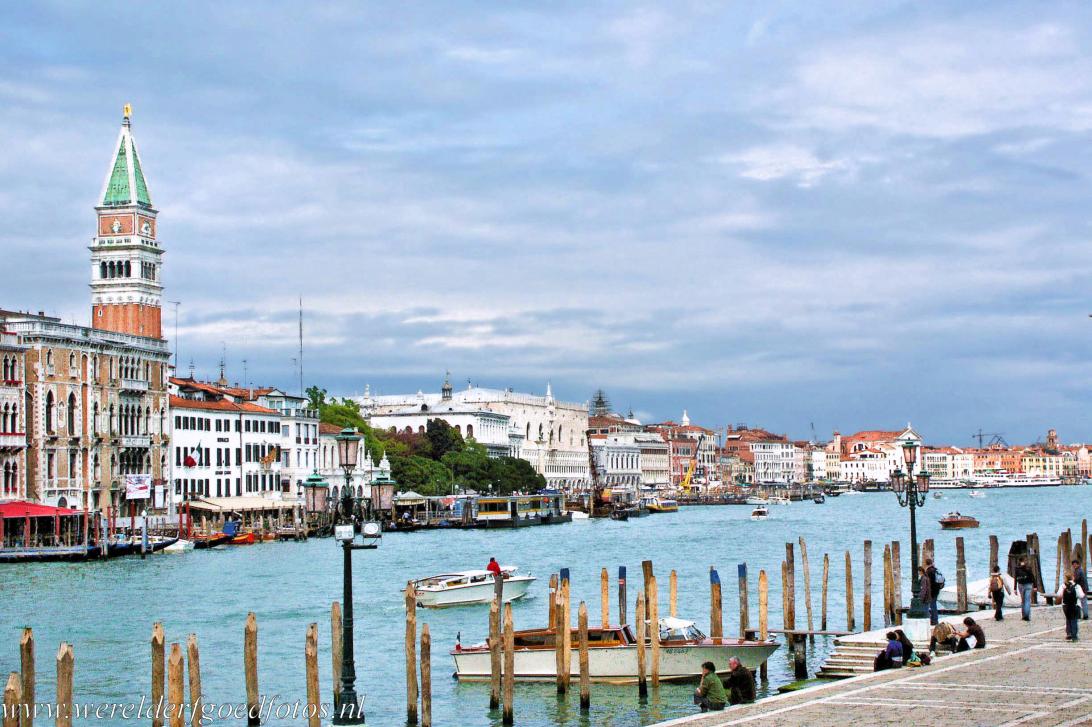
Venice and its Lagoon: The Canal Grande and St. Mark's Campanile. Venice was founded in the 5th century and became a maritime power in the 10th century. Venice was built on 118 small islands in the Lagoon. The city of Venice is a masterpiece of art and architecture. Venice and its Lagoon were inscribed on the UNESCO World Heritage List in 1987.

Venice and its Lagoon: The Canal Grande and St. Mark's Campanile. Venice was founded in the 5th century and became a maritime power in the 10th century. Venice was built on 118 small islands in the Lagoon. The city of Venice is a masterpiece of art and architecture. Venice and its Lagoon were inscribed on the UNESCO World Heritage List in 1987.

Venice and its Lagoon: A gondola sailing on a narrow canal. For centuries, the gondola was the main form of transportation in Venice, they were well suited to the conditions of the Venetian Lagoon. The gondolas are decorated with a pair of seahorses and a bronze Lion of Saint Mark. Venice and its Lagoon were declared a UNESCO World Heritage in 1987.
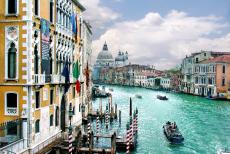
Venice and its Lagoon: The Canal Grande and the Basilica of Santa Maria della Salute viewed from the Accademia Bridge. The Galleria dell'Accademia is situated on the banks of the Canal Grande, near the Accademia Bridge. The Galleria dell'Accademia houses masterpieces of the greatest artists in the world, such as Giovanni Bellini, Titiaan and Tintoretto.
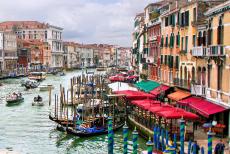
Venice and its Lagoon: Gondolas on the Canal Grande viewed from the Accademia Bridge. The Canal Grande, the Grand Canal, is the main waterway in Venice, it is almost four kilometres long and lined with buildings from the 13th century to the 18th century, most of the buildings were built by wealthy Venetian families.
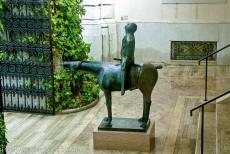
Venice and its Lagoon: A bronze sculpture by the Italian sculptor Marino Marini at the entrance to the Palazzo Venier dei Leoni in Venice. The palace houses the Peggy Guggenheim Collection. The Peggy Guggenheim Collection hosts American and European art from the beginning of the 20th century. Among them works of Pablo Picasso and Max Ernst.
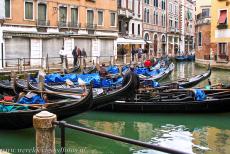
Venice and its Lagoon: Gondolas on the Canal Grande in Venice. Cars are banned in Venice. The only way to get around is by foot and by boat, a vaporetto, a water bus, a water taxi, or gondola. In Venice, there were about eight to ten thousand gondolas during the 17th and 18th centuries. Nowadays, there are about 400 gondolas in Venice.
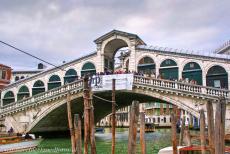
Venice and its Lagoon: The Rialto Bridge is spanning the Canal Grande in Venice. The bridge is one of the most famous bridges in Venice. The Rialto Bridge was built in 1591 and is the oldest bridge across the Canal Grande, the bridge has become one of the architectural icons of Venice. The bridge is connecting the districts of San Marco and San Polo.
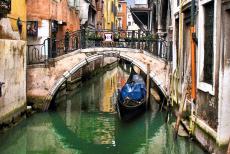
Venice and its Lagoon: A gondola on a narrow canal in Venice. The first gondolas were used in Venice in the 11th century. A 16th century Venetian law required that all gondolas should be painted black. Nowadays, there are more than 400 gondolas in Venice, only used by tourists. Venice and its Lagoon were inscribed on the UNESCO World Heritage List in 1987.
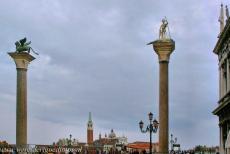
Venice and its Lagoon: The two columns in the Piazzetta near the Basilica San Marco. One of the columns in the Piazzetta is topped with the bronze Lion of Saint Mark, a symbol of Venice. The other column is topped with a statue of Saint Theodore, the patron saint of Venice before Saint Marco. In the background the St. Mark's Basilica and the Campanile.
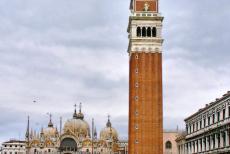
Venice and its Lagoon: The Piazza San Marco with the St. Mark's Basilica and the Campanile. The original St. Mark's Basilica was built in the period 829-836. This church was destroyed by a fire in 976. The present St. Mark's Basilica was built in 1043-1071, the basilica was consecrated in 1094. The interior is adorned with gilded Byzantine mosaics.
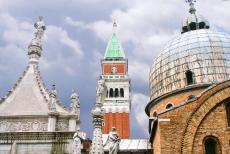
Venice and its Lagoon: St. Mark's Basilica and the Campanile, the bell tower. La Marangona, one of the bells, survived the collapse of the tower in 1902. The Byzantine St. Mark's Basilica with its five cupolas is probably the most well known building in Venice. The basilica houses numerous works of art from the Byzantine period, such as gold, silver, glass objects and mosaics.
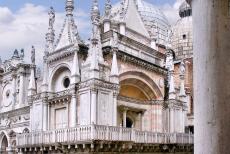
Venice and its Lagoon: The St. Mark's Basilica main entrance is the Porta di San Clemente. The basilica was built to house the remains of St. Mark the Evangelist. It took several centuries to decorate the interior and exterior of St. Mark's Basilica. The main façade of St. Mark's Basilica was built to serve as an altar, people could participate in ceremonies from the St. Mark's Square.
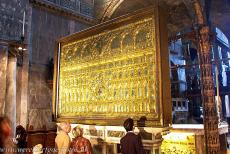
Venice and its Lagoon: The Pala d'Oro is the Byzantine altarpiece of the St. Mark's Basilica, made of gold and enamel and embellished with hundreds of gems, the Pala d'Oro dates from the 10th century, but some parts date from the 12th and 14th centuries. The Pala d'Oro depicts the life of Christ. The relics of Saint Mark the Evangelist rest in a tomb behind the high altar.
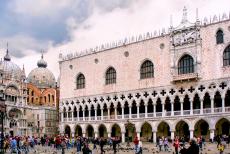
Venice and its Lagoon: The Doge's Palace in Venice was built in the period 1309-1424, on the left hand side the St. Mark's Basilica. The Doge's Palace is a true masterpiece of the Venetian Gothic style. The palace was the residence of the Doge of Venice, the leader of the Republic of Venice. The Doge's Palace became a museum in 1923.
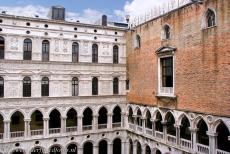
Venice and its Lagoon: The courtyard of the Doge's Palace. The Porta della Carta leads into the central courtyard via the Foscari Arch. The courtyard is surrounded by an arched gallery, built in the Gothic style, the decoration already show Renaissance influences. The fourth side of the courtyard is formed by the adjoining St. Mark's Basilica.
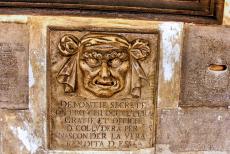
Venice and ist Lagoon: The Bocca di Leone, the Mouth of the Lion, is embedded in the wall of the Doge's Palace. The Bocca di Leone was a post box used for secret accusations, one Venetian could denounce another, the note had to be signed, also by two witnesses, their names would remain known only to the magistrate of the Venice.
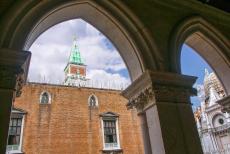
Venice and its Lagoon: The St. Mark's Campanile viewed from the Doge's Palace. The St. Mark's Campanile is the bell tower of the St. Mark's Basilica, it was probably built in the 12th century. The tower collapsed in 1902, but was rebuilt exactly as it had been. The tower is 99 metres high and is topped with a golden statue of the Archangel Gabriel that functions as a weathervane.
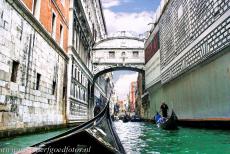
Venice and its Lagoon: Gondolas passing under the Ponte dei Sospiri, the Bridge of Sighs. The bridge is spanning the Rio del Palazzo, the Palace River, the channel which separates the Doge's Palace and the prison. The Bridge of Sighs was constructed in the Renaissance style in 1602. The limestone bridge is decorated with sculptures, depicting sad or angry faces.
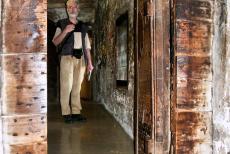
Venice and its Lagoon: The inside of the Bridge of Sighs, the bridge joins the inquisitor's room inside the Doge's Palace with the prison of Venice. The convicted prisoners were brought from the Doge's Palace via the Bridge of Sighs to the prison, the most famous prisoners who crossed the bridge were Galileo Galilei en Casanova.
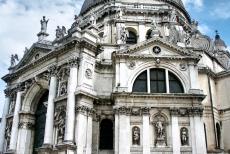
Venice and its Lagoon: The Baroque Basilica of St. Mary of Health and Salvation stands on the banks of the Canal Grande. The Basilica di Santa Maria della Salute, the Basilica of St. Mary of Health and Salvation, was built after the ending of the plague that had afflicted Venice in 1630, the basilica was completed in 1687. The dome of the basilica adornes the skyline of Venice.
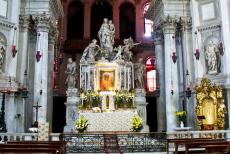
Venice and its Lagoon: The High Altar of the Basilica di Santa Maria della Salute. The High Altar is adorned with the holy icon of Panagia Mesopantitissa, a Byzantine Black Madonna. The icon comes from the Greek Island of Crete and was brougth to Venice in 1669. The icon date back to around the 12th or 13th century.
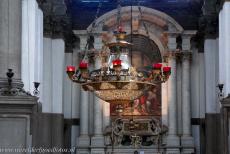
Venice and its Lagoon: The interior of the Basilica of St. Mary of Health and Salvation, the Santa Maria della Salute. The basilica is an octagonal church building with two domes and bell towers. The great dome represents the crown of the Virgin Mary, the patroness of the basilica. Most of the art objects in the church refers to the bubonic plague, also known as the Black Death.
